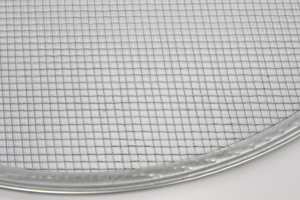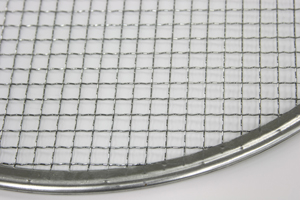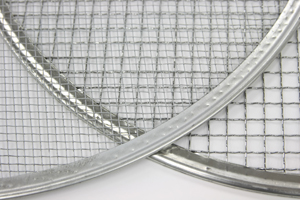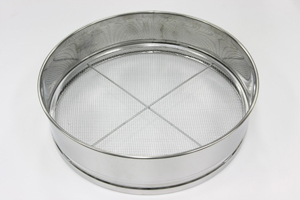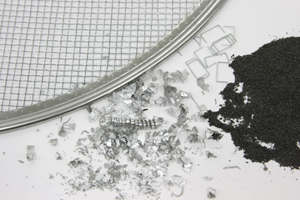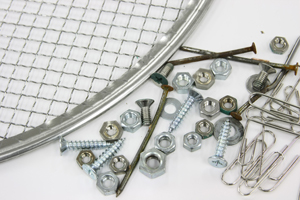Bar magnets
Which is better 12000 gauss or 14000 gauss
Usually it is considered that stronger the magnet, the better. However that is not necessarily true. It will depend on the affected area including the distance that can be reached by the lines of magnetic force and the total flux emitted from the entire surface. With bar magnets, it also depends on the magnetic substance that is attracted to the magnet and the installation environment. To determine whether 12000 gauss or 14000 gauss would be better, please refer to the comparison chart below.
| Surface inductive density | Adsorption point | Fine powder & iron powder | Short distance attraction capacity | Long distance attraction capacity | Distance | Affected area |
|---|---|---|---|---|---|---|
| 12000G | ○ | ○ | ○ | |||
| 14000G | ○ | ○ | ○ |
What is the difference between 12000 gauss and 14000 gauss?
In regards to the magnetic properties, the surface inductive flux, lines of magnetic force and magnetic field are different. In simple terms, the difference is whether the magnet filter has a rough or fine filtration.
| Surface inductive density | Filtration |
|---|---|
| 12000G | Fine, thin |
| 14000G | Rough, thick |
What can be filtered using a 12000 gauss bar magnet and 14000 gauss bar magnet?
For items that are difficult to pick up using one's fingers 12000 gauss is suitable and for items that are large enough to be picked up using one's fingers 14000 gauss is recommended. However, it is not compulsory to choose according to the above because both types are very strong and have excellent attraction capacity.
| Surface inductive density | Object | Target |
|---|---|---|
| 12000G | Fine powder & iron powder Chips, iron dust, needles |
Fine objects Small objects |
| 14000G | Bolts, nuts Screws, clips |
Thick objects Large objects |
Does the distance reached by the lines of magnetic force differ according to the internal structure?
Bar magnets are embedded so that they repel the N and S poles of the neodymium magnets embedded in the stainless steel case. The affected area in which magnetic substances can be attracted will differ according to the thickness of the embedded magnets. If the embedded magnet is thin with a thin pitch, the lines of magnetic force will be low and short. In comparison, the lines of magnetic force for a thick magnet with a thick pitch will be long and reach far. Generally speaking, the affected area is larger if the lines of magnetic force are longer.
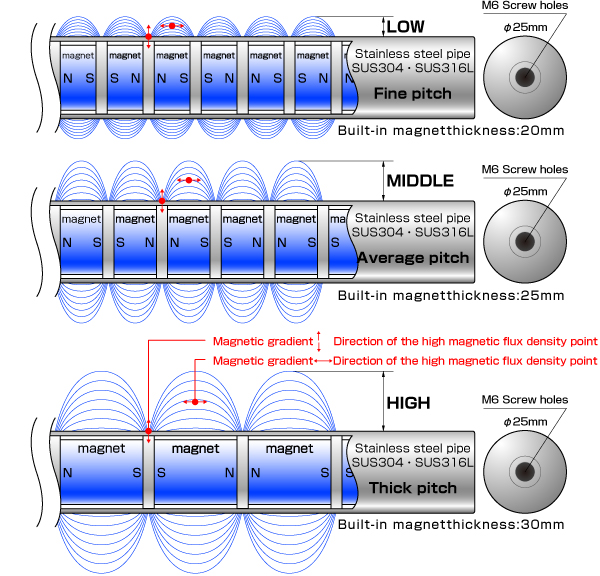
Is there a difference in the number of adsorption points with a thin and thick pitch?
There are many adsorption points with a thin pitch and fewer with a thick pitch. Generally it is considered the more adsorption points the better.
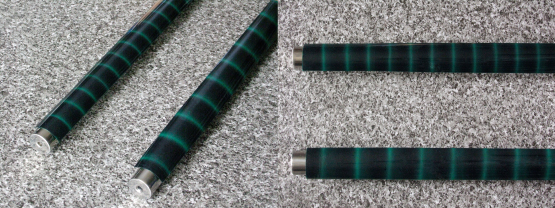
When seen through a magnet viewer.


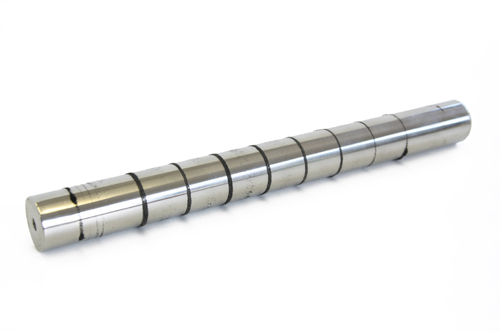
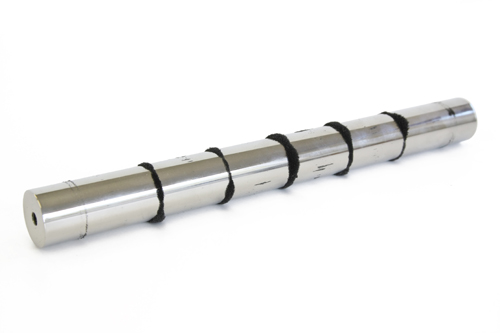
Iron powder spilt over the bar magnet.
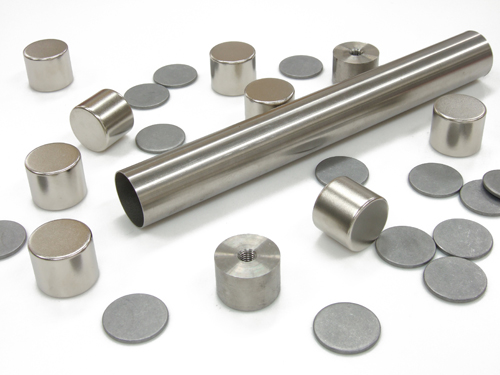
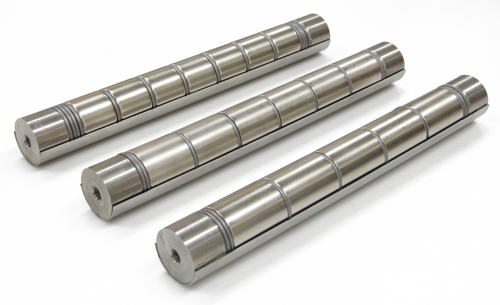
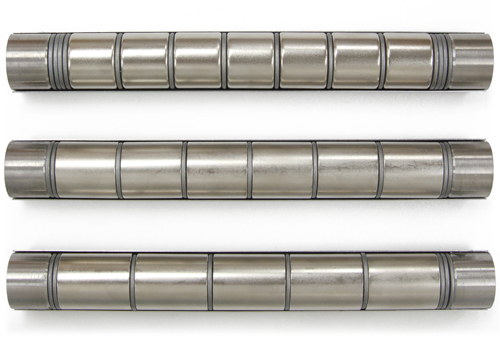
View of inside the bar magnet
What is the relevance of the factors of the embedded magnets?
When laying out and assembling together several bar magnets, it is important which end is the N pole and which end is the S pole. A strong magnetic filter can be created by assembling them in a way that they are magnetically compatible. Generally speaking, the magnetic filter will be stronger if the number of embedded magnets is an odd number rather than an even number. It is also easier to assemble an odd number of magnets.
- If there is an odd number of embedded magnets
-
The N and S poles of the laid out bar magnets are magnetically compatible thus creating a strong magnetic filter. It is possible to easily assemble several bar magnets so that they are compatible.
- If there is an even number of embedded magnets
-
The N and S poles of the laid out bar magnets will repel each other thus creating a magnetic filter that is weaker than if there is an odd number of embedded magnets. If there are several bar magnets, they will repel each other making assembly extremely difficult.
*We can resolve the above by making two rows, one with an N pole on either end and the other with an S pole on either end. This way, even with an even number of magnets, the layout will be compatible.
Parallel rebound
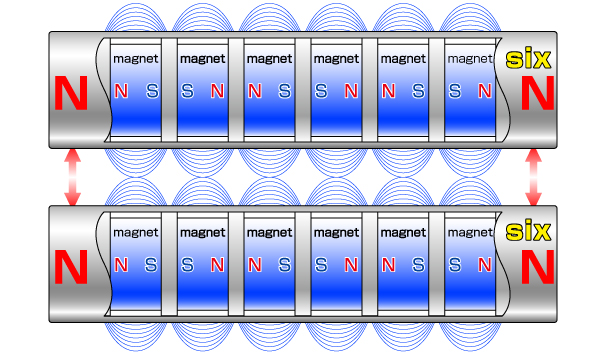
| Built-in magnet Number |
Even 2/4/6/8/10/12/14/16 |
|---|
Parallel adsorption
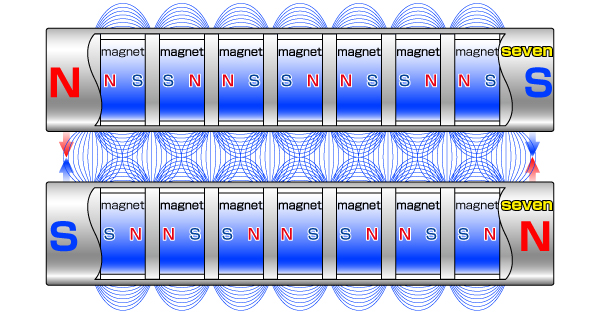
| Built-in magnet Number |
Odd 3/5/7/9/11/13/15/17 |
|---|
| Embedded magnets | Factors | Compatibility | Repulsive resistance | Magnetic force | Attraction capacity | Ease of assembly |
|---|---|---|---|---|---|---|
| Even numbers | 2,4,6,8,12,16 | |||||
| Odd numbers | 3,5,7,9,11,13 | ○ | ○ | ○ | ○ | ○ |
How are lines of magnetic force emitted? Simulation of magnetic fields
You can see that the lines of magnetic force reach further with a thick pitch rather than a thin pitch type. On the other hand, with the thin pitch type, there are many adsorption points and the total inductive flux is higher.
Embedded magnets 20mm (Fine pitch) type
Attraction distance of magnetic substance approx.20mm from surface
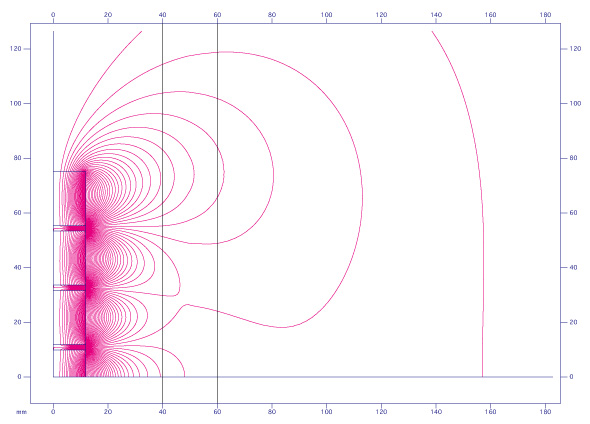
Embedded magnets 25mm(Regular pitch)type
Attraction distance of magnetic substance approx.25mm from surface
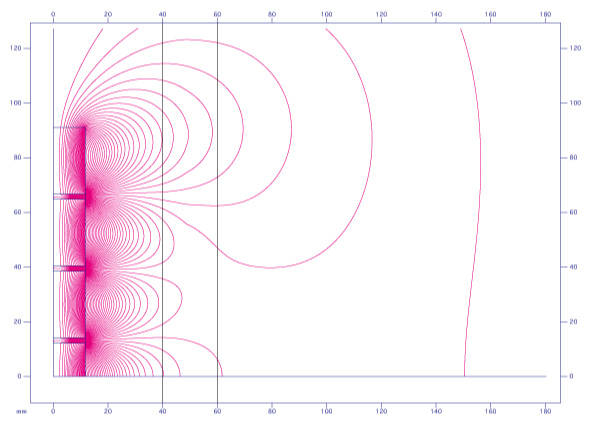
Embedded magnets 30mm(Thick pitch)type
Attraction distance of magnetic substance approx.30mm from surface
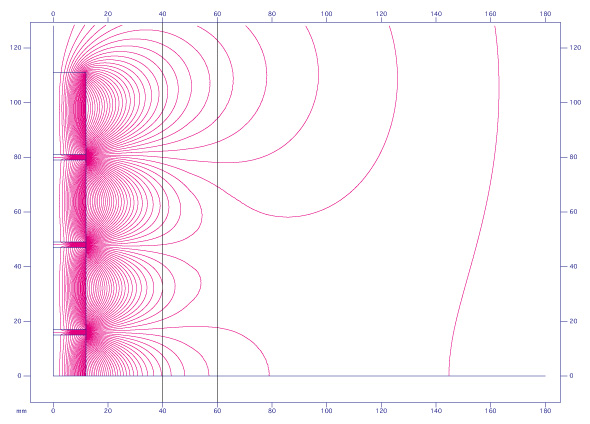


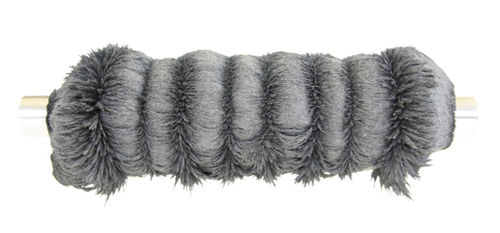
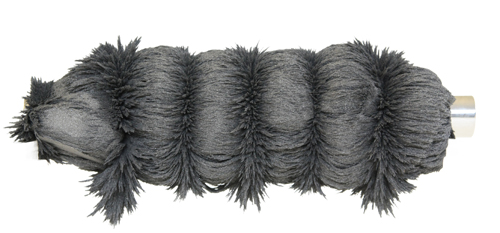
The lines of magnetic force when iron powder is spilt over a bar magnet.
Doesn't the exterior stainless steel case rust?
The stainless steel cases for bar magnets are made using SUS 304, SUS316 or SUS316L all of which have excellent corrosion resistance properties. SUS304 is sufficient for use in fresh water. SUS316 is recommended if you are using the bar magnet in an environment in which it would come into contact with salt water or chemicals. Even with SUS316, the bar magnet may rust if it comes into contact with rock salt or salt in high concentrations.
| Outer case | Corrosion resistance | Object | Characteristics | 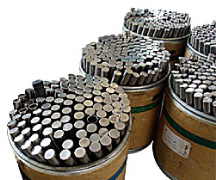 |
|---|---|---|---|---|
| SUS304 | ○ | Fresh water & no salt | They are usually widely used in food factories. | |
| SUS316L | Salt water & chemicals | They have corrosion resistance and pitting corrosion resistance that can withstand salt water. |
Sizes that can be made for round shapes
The feasible sizes and diameters of the tapped holes for our exterior stainless steel case for bar magnets differ according to the exterior diameter.
Reference images φ9.5mm,φ25mm,φ50.8mm,φ80mm
| Diameter | Max screw | Longest mm | Tesla | Gauss |
|---|---|---|---|---|
| φ9.5mm | M4 | 4000 | 0.6 | 6000 |
| φ16mm | M6 | 4000 | 1.2 | 12000 |
| φ19mm | M8 | 4000 | 1.2 | 12000 |
| φ20mm | M8 | 4000 | 1.2 | 12000 |
| φ22mm | M8 | 4000 | 1.2 | 12000 |
| φ23mm | M8 | 4000 | 1.2 | 12000 |
| φ25mm | M8 | 4000 | 1.4 | 14000 |
| φ28mm | M8 | 3000 | 1.4 | 14000 |
| φ32mm | M8 | 3000 | 1.4 | 14000 |
| φ38mm | M10 | 3000 | 1.4 | 14000 |
| φ50mm | M10 | 2000 | 1.4 | 14000 |
| φ76mm | M10 | 1000 | 1.4 | 14000 |
| φ100mm | M10 | 1000 | 1.4 | 14000 |
*We can make these products. *We do not handle SUS304L.
| Tolerance | Diameter | 100mm | 200mm | 300mm | 400mm | 500mm | 600mm | 700mm | 800mm | 900mm | 1,000mm |
|---|---|---|---|---|---|---|---|---|---|---|---|
| φ25mm | 0.05mm | 0.5mm | 0.5mm | 0.65mm | 0.7mm | 0.7mm | 0.85mm | 1.0mm | 1.0mm | 1.1mm | 1.1mm |
*In order to specify the dimension tolerance, the product must be custom-made. Our standard products in stock do not meet the above tolerance.
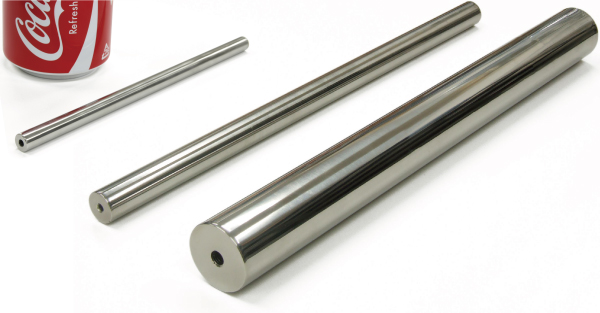
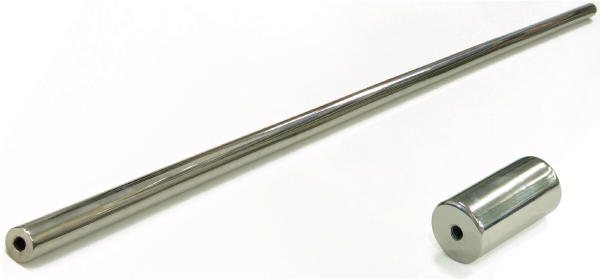

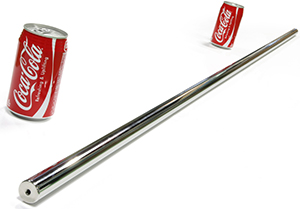
Sizes that we can make for square shapes
The feasible sizes and diameters of the tapped holes for our exterior stainless steel case for bar magnets differ according to the exterior diameter.
Reference images 10mm,25mm
| Exterior standards | Squares | SUS304 | Maximum tapped hole | Shortest size | Longest size |
|---|---|---|---|---|---|
| UNS10 | 10mmX10mm | ○ | M4 | 30mm | 4,000mm |
| UNS15 | 15mmX15mm | ○ | M6 | 40mm | 4,000mm |
| UNS20 | 20mmX20mm | ○ | M8 | 40mm | 4,000mm |
| UNS25 | 25mmX25mm | ○ | M8 | 50mm | 4,000mm |
| UNS32 | 32mmX32mm | ○ | M10 | 50mm | 3,000mm |
| UNS50 | 50mmX50mm | ○ | M12 | 60mm | 2,000mm |
*We can make these products. *We do not handle SUS304L.





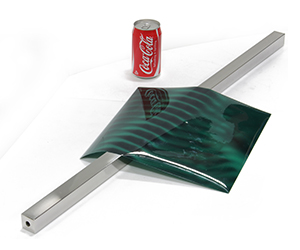
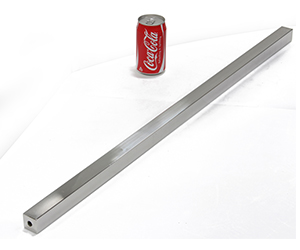

 Discs / Rods
Discs / Rods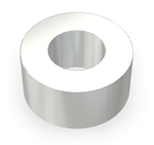 Rings
Rings Arc Segment
Arc Segment Squares
Squares Spheres
Spheres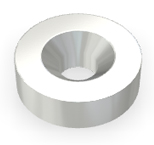 Disc Countersunks
Disc Countersunks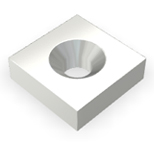 Square Countersunks
Square Countersunks A-Disc Countersunks
A-Disc Countersunks B-Disc Counterboreds
B-Disc Counterboreds C-Thread Male
C-Thread Male D-Thread Female
D-Thread Female E-Hooks
E-Hooks F-Eyelet hook
F-Eyelet hook G-Discs
G-Discs H-Filettatura Interno
H-Filettatura Interno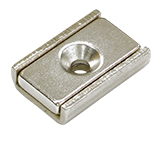 LA-Square Countersunks
LA-Square Countersunks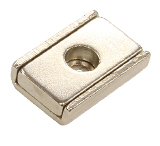 LB-Square Counterboreds
LB-Square Counterboreds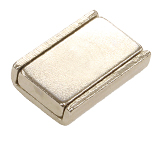 LG-Squares
LG-Squares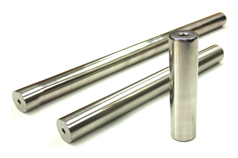 Bar
Bar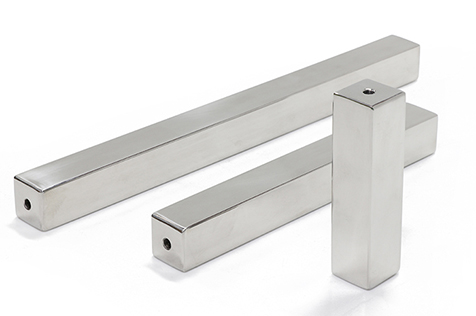 Square
Square Rectangular Filter
Rectangular Filter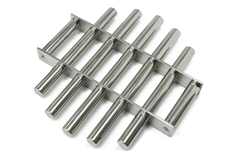 Round Filter
Round Filter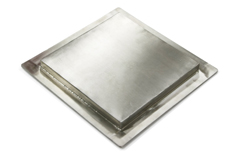 Plate
Plate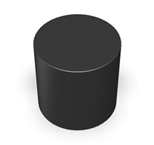 Discs / Rods
Discs / Rods Squares
Squares Discs / Rods
Discs / Rods Rings
Rings Squares
Squares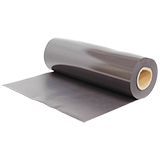 Rubber magnets
Rubber magnets Discs / Rods
Discs / Rods Squares
Squares